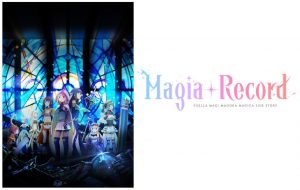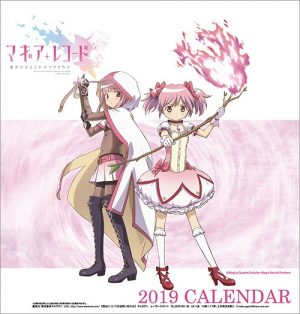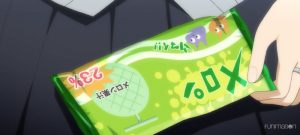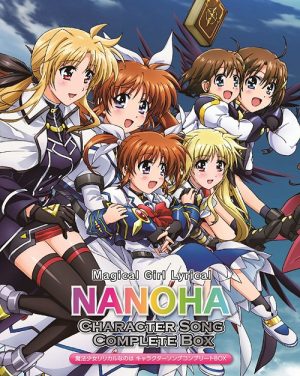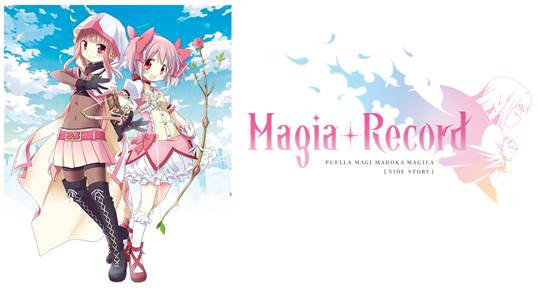
Magia Record: Mahou Shoujo Madoka Magica Gaiden (Magia Record: Puella Magi Madoka Magica Side Story) is an anticipated addition to a beloved franchise. As a side story, Magia Record is an adaptation of a mobile game with a cast of new characters.
With a new story comes a new direction. Magia Record builds upon older ideas while distinguishing itself from its predecessor. This new direction manifests in an emphasis on a visual “center,” a coming together of different myths, philosophies, and arts.
Before continuing, I’d like to caution readers. As the anime is young, I’ll highlight observations I think are noteworthy, but please consider this article a pondering of ideas more than an analysis of them. With that stated, I hope my insight proves interesting.
An Emphasis on Center: a Visual Middle
Whereas its predecessor used lighting to show a world of separation (light/dark, hope/despair, innocence/knowledge), Magia Record seems to emphasize a middle ground, a gathering place of various ideas.
With the last three episodes, certain observations support this. To begin, three cities are confirmed within Magia Record: Takarazaki City (the home of Iroha), Kamihama City (the home of several new characters), and lastly, Mitakihara City (the main city of Madoka Magica).
Kamihama City is the center of our story, the gathering spot for witches, magical girls from different cities, and several rumors. In the first episode, it’s mentioned that “Magical Girls can be saved if they go to Kamihama City.”
Near the end of this episode, there’s a dream sequence where Iroha chases after her sister Ui. As Ui walks into the distance, she stops for a moment and turns towards the camera. This shot places her between the moon above and the sun setting at her feet.
The curvature of the ground, makes it seem as if the world rests behind her--that Kamihama City exists between reality and dream. However, unlike rumored, it’s not necessarily a sanctuary. Rats are shown instinctively running away, implying danger.
At the end of episode 3, we’re given a shot of freeway signs. It reads that 3 highways (Hokuyo-ku, Sankyo-ku, and Chuo-ku) connect to Kamihama City despite coming from different directions. This implies, “all roads, whether in a dream or reality, connect to Kamihama City.”
This city is the center of salvation, the key to Iroha’s lost memory, and the endpoint of insidious rumors. In a way, it’s the center of many movements both figurative and literal.
Renaissance and Context
The original Puella Magi Madoka Magica was rich with imagery. From its prominent churches to the Creation of Adam in episode 11, Madoka Magica conveyed a story of duality, before and afters, and separation. However, Magia Record seems to take a different approach.
As stated in the previous section, Magia Record seems to emphasize “a center” whether that’s in its setting, plot, or in visual shots. One reason might be deduced from its visual designs. Featured throughout Magia Record are possible borrowings of Renaissance ideas.
The Renaissance was an emergence of the art, literature, philosophy, and history that coincided with a revival of interest in Greek and Roman culture. This period is debated amongst scholars to be roughly between the 15th century and 16th century, but some argue it started as early as the 12th century and ended possibly in the 17th century.
However, while the Renaissance occurred all over Europe, Italy was a major center for trade, resulting in Italy’s impact on the Renaissance. As trade was crucial, the study of astrology was important as it guided ships from one port to the next. This focus eventually leads to Nicolaus Copernicus developing heliocentricism (although, if this is solely his own idea is debated), the idea that the sun is the center of the universe.
With that brief overview, let’s now discuss Magia Record.
Kamihama City: A Center of Ideas
Kamihama City is at a cultural crossroads. As the center of the story, characters migrate there for different reasons: salvation, memory, and rumors. However, characters don’t only bring themselves, they can also bring their culture and “trade” their ideas.
To reach Kamihama City, characters use public transportation. In particular, trains are a common choice for our young characters. At each train stop, prominent astrological symbols are displayed, reminding viewers of the ancient use of astrology--navigation.
In episode 1, once Iroha crashes into Kamihama City, Zenobia, a sandbox witch, “greets her.” Zenobia’s name means “life of Zeus” or “daughter of Zeus,” and her design features a planet with rings for her top. This planet is most likely Jupiter (which, like Saturn, also has rings around it). Jupiter is the Roman name of the Greek god Zeus.
This melding of cultures goes further. 12 minutes into episode 2, Iroha visits a hospital where her sister was presumedly hospitalized. Satomi Medical Center is located within Kamihama City, and during a dream sequence, viewers are able to see its design.
Above the front desk is the warrior goddess Athena, a Greek Goddess who presided over wisdom, law, strategy, and the arts. She is commonly depicted wearing a helmet and holding a spear and shield. In the Satomi Medical Center, her shield has a gorgon’s head, fitting as she was the goddess who gave Perseus a shield to slay Medusa and her sisters.
Continuing further, after the fight with the sheep witch in episode 2, Iroha is saved by Rena, Kaede, and Momoko. They bring her to a building owned by a Coordinator. According to Momoko, this building is “like a hospital, or like a counseling center for Magical Girls.” In episode 3, we finally see the Coordinator at work. Her name is Mitama Yakumo and her job is getting magical girls “adjusted.”
She explains, “Having your Soul Gem adjusted can bring power to the fore that you never knew you had before!” As she clarifies, a famous Renaissance drawing flashes on the screen, the Vitruvian Man by Leonardo da Vinci. This image eventually cuts to Yakumo turning on lights as her explanation “dawns” on the viewers.
Just like Kamihama City, Yakumo’s building is a mixture of ideas. To begin, just as her title implies (Coordinator), her building is filled with devices that tell location. There are “globe-like” structures held together with a frame. This frame allows it to spin like a typical globe one might see in a classroom.
However, replace the middle (the earth) with what Yakumo really coordinates--soul gems. These soul gems are designed to look like birdcages, borrowing imagery from the original Madoka Magica (and the Rebellion movie). The pillars that hold the roof are also distinctly Greek pillars. Placed behind these pillars is a bright wall, lit in a translucent blue. At its center is a cross with “coordinates” at key sections.
As I’ve discussed in my Madoka Magica article series, the original show uses religious (Christian) imagery. The Renaissance is also a period where devout artists painted key biblical subjects like the Madonna, Jesus Christ, and God.
While this cross could be a coincidence, it wouldn’t be illogical to assume otherwise--especially after episode 3. Characters from Mitakihara City (Madoka Magica’s setting) are implied to be joining the story.
From a different perspective, that cross could be an intersection. Just as Yakumo is trying to coordinate groups together, Kamihama City is at the intersection of dreams and reality, myths and science, ideas and rumors. It is the place where both witches and magical girls are finding a new center.
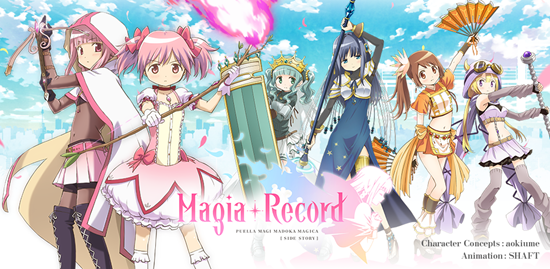
Final Thoughts
Magia Record is a collage of characters, settings, and ideas. While it’s still early on, what I’ve seen has a lot of promise. As stated before, this article is merely a pondering of ideas and observations. However, if my thoughts have proved interesting, I hope you’ll continue watching the show or take an interest in it.


